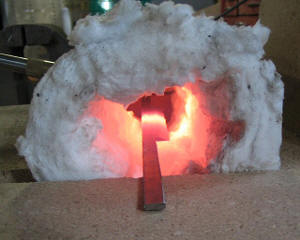| |
The Travisher I've made here is a "start
from scratch" one. One of the demonstrations and
classes that I put on is in the making of tools. I try
to make these tools with as commonly available material
as I can and make them usable ... not just for show. I
tend to make larger, chunkier handtools as they are far
more comfortable in my hands than the small handled,
dainty tools that you feel like should be in a museum
and not on your bench. I use these tools almost every
day and I use them, especially this one, for hours on
end. They have to be comfortable! So, here's one
version of a Travisher.... |
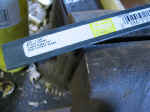 |
Basic ol' plain steel that you can get
at your nearest home center. Sure, flat toolsteel stock
or HSS would work better and last longer between
sharpenings but you can't always find that stuff or have
the equipment to work it properly. For this tool, this
metal is fine. Not great, but fine. Update 8/09:
I make the ones that I regularly use and sell to other
people out of O-1 tool steel. It's not as tough as HSS
(high speed steel) but it's a whole lot easier to work
without specialized industrial equipment. |
 |
Mark out how big you want the cutting
edge and how long you want the "tangs" on each side to
be. Cut, grind, or whatever you want to get rid of the
waste. Update 8/09: The thickness, width and
length of the steel stock you start with greatly depends
on what, exactly, you're going to be working on with
your own travisher and just your own preferences.
Normally, I start with at least 3/16" thick x 3/4" wide
x 12" long stock. The thicker your stock is, the less
chatter you'll have when slicing the wood. 1/4" thick
is the thickest I've made. Too wide of a travisher
(over 1") and you can't scoop out within tighter
radius's. |
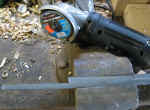 |
Cut the handles out using whatever tools
you have available. |
 |
Try to get the same length handles at
this point. But if you don't, not to worry. It's always
best to leave a bit extra and cut off what you don't
need later. The blade area is only about 3.5" to 5"
long. Make it larger or smaller as you need it. |
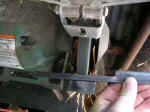 |
Grind the handles and everything fairly
smooth so it'll fit into your wooden handles later and
so that it's easier / safer to do your bending in the
next steps. |
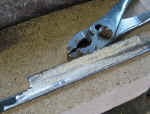 |
Decide which side is going to have the
bevel in it and the other side is going to be flat.
Grind the flat side so that it is really flat. This side
is what is going to be riding against the wood. It needs
to be smooth. You can see here were I've done a
rough grind on the flat side. I'll progress down to
finer grits to make this as smooth as possible.
Actually, it'll be shiny and polished enough eventually
so that I can see my pretty face! Or at least
somebodies pretty face. |
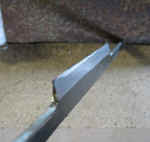 |
After you get done with the flat side,
start grinding the bevel side. Again, this is a picture
of the rough grind. I'll take this down pretty far in
grit size but I won't get it polished at this stage.
There's still lots to do and it'll be a waste of time to
do all of that grinding and polishing right now. But at
least we want it roughed out and ground properly. It's
easier to rough it out while the thing is still
straight. |
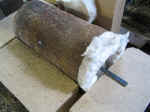 |
Here's a little portable forge that I
use sometimes. It's a piece of water well casing (VERY
tough stuff) with a little hole drilled in one side for
the gas torch to fit into. The white stuff is Kaowool.
It's a very very efficient insulator and refractory
material designed for fireplaces, forges and high-temp
kilns. That's just loosely rolled into the steel tube.
You can see the travisher steel sticking out of the
forge ready to be heated and bent. |
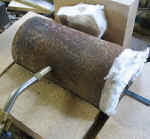 |
There's the torch in the hole and
starting to fire up. It doesn't take long to get things
up to cherry red and ready to bend. Maybe 2 minutes and
it's ready. |
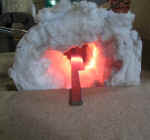 |
And there it is just starting to get red
in the middle. Wait until it gets cherry red all over
the blade area before you start bending. I use safety
equipment (imagine that!) for handling the steel such as
special gloves, long tongs, etc. I highly recommend
that you do too. If you don't know what you are doing
and aren't confident that you aren't going to burn
yourself; explode things; or kill yourself with carbon
monoxide fumes then DON'T DO IT. It can be very very
very dangerous stuff. Lots of stuff to consider when
doing this sort of thing. Make sure you know what
you're getting into first! |
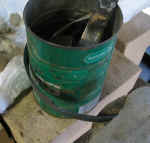 |
Once the steel is up to where you're
ready to bend it, well, ..... bend it already! You'll
really need to use a form to bend this around. I'm
using one of those new-fangled impact-resistant
high-tech shop storage containers ... an old coffee can
here. I don't drink coffee (yeck!) so I have to do
something with the cans when I dump the coffee out.
<grin>
Now, you're probably asking yourself ... "Self, isn't
he suppose to be making a travisher in this article?"
and yourself answers back "Well, yeah, he is.
Why such a huge curve shown there?" Good
question you two. In this and the next couple of
pictures, I'm actually making a scorp but then go back
to the pictures of making a travisher. The two
tools are very similar in construction except for just
the radius of the blade and how the handles are bent.
|
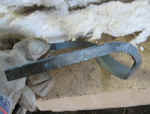 |
So, here's our Travisher (ahem ...
actually the scorp) all bent up. The handles are bent
down so that they'll fit into your wooden travisher
body. I tend to make the travisher wooden bodies FIRST
so that I can fit the handles into that instead of the
other way around. |
 |
Another view of it. |
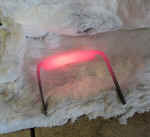 |
The last step is heat treating it. I
put it into the kiln and harden it. Quench. Polish up
the blade so that I can see the raw steel really well.
Gently, ever so gently, heat the blade up until light
straw color and then quench again to temper the blade a
little. We want it hard but not TOO hard or it'll be
brittle. I won't go into all of the details of the heat
treating process here. That whole thing is an
incredibly deep subject and rife with conflicting
"facts" and procedures that everybody with an opinion is
absolutely, positively sure they know the correct way to
do it. And books are no help either. Almost all of
them conflict heavily with the others. *Sigh* |
| |
|
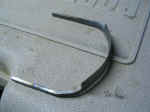 |
Our blade is now ready for a body.
Notice that we're back to the real Travisher blade now.
Update 8/09: The radius on travishers are very
dependent the users preferences. Also, the shape of
that radius. Some like it fully round. Some like it
rounded as in the picture at left. Others like
theirs to be round and then sort of squared off at each
end. Same goes for scorps, too, by the way. Start out
with a nice, gentle radius and don't get too excited
about getting a perfect round shape all the way to the
ends at first. Use it, and decide for yourself what you
really want/need. This travishers' blade is 5" long
before bending and about 4.5" from end to end after the
bend. |
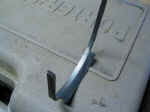 |
Another view. |
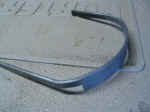 |
Still another view. After all of the
heat treating, I take my time to get a really polished
flat side, bevel and everything else around that blade
area. It's going to be rubbing up against the wood and
any sort of bump will be transferred to the wood. |
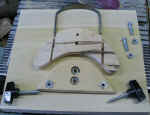 |
All of the parts laid out in a rough
estimate of how it'll go together. |
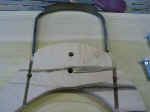 |
Make sure that the blade handles / tangs
fit into the main section of the wooden body. |
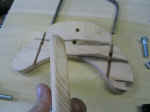 |
Here's the toe. I made it as a separate
piece so that it could be replaced as needed. |
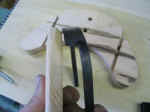 |
Blade fits into toe like so |
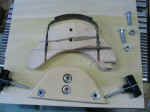 |
|
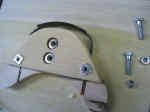 |
Basically, the thing is workable. Not
pretty. But workable and fits MY hands. When I'm making
these for other people, I don't make the wooden bodies
like this, obviously. But for just me ... I don't worry
about all of that. Form absolutely follows function (ie
I don't care what my own tools look like as long as they
work well) for tools and equipment in my own shop.
|
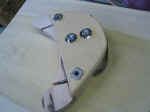 |
|
 |
Tada! |
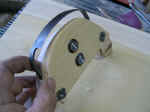 |
Blade goes uppppp. |
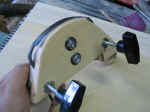 |
Yeah, I know those knobs are HUGE. I
replaced them later with small thumb screws. But these
are all I could find when I was taking pictures. |
 |
Blade goes dooooowwwwnnnn. |
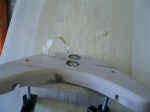 |
And a little test cut. Hmmmm not bad. |
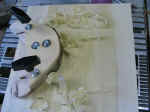 |
A little slice here and there ... |
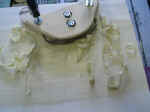 |
Getting better.... |
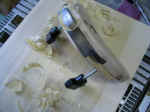 |
Some nice shavings with a tool that I
made myself from start to finish. |
 |
No better feeling. Now I have to get to
the real work! |
 |
Here's a new travisher in the process of
being made. It's mesquite wood and more of a
traditional travisher shape. Mesquite is a fairly hard
wood and should be fine for this tool. |
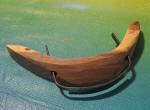 |
The body has been roughed out and a
little light easing-off of the throat to check that this
blade will work. The next step is to very
carefully shape the curve to get a perfect fit for that
blade edge. Holes will then be drilled for set screws
to hold the blade tangs in place. After that, the rest
of the body can be rounded and shaped to be comfortable
in the hand. |
